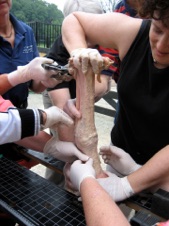Karen Gellman DVM, PhD
Equine Sports Medicine



Karen Gellman DVM, PhD
Equine Sports Medicine



Living with Gravity
I came to veterinary medicine somewhat late in life, after a career in the arts. Having to study physics in preparation for vet school, I was strongly struck by the beauty and inevitability of simple Newtonian mechanics. In my first semester of vet anatomy, one of my teachers was Dr. John Bertram, a scientist specializing in comparative biomechanics. Comparative biomechanics looks at how the laws of physics influence the structure and function of different organisms. After completing my DVM degree, I undertook graduate studies in locomotion biomechanics with Dr. Bertram, focussing on the effects of body size (scaling) on the degree of passive mechanisms necessary for life on earth. To put it simply, the large and faster an animal is, the less metabolic energy per unit of body weight it has to devote to living. So large, fast animals like horses have a significant physical pressure to develop body structures that can operate with the minimum of energetic cost.
Since I had a clinical interest in the function of the back and neck, I obtained post-graduate clinical training in acupuncture and chiropractic manipulation, as being the best known modalities to address these problems. In graduate school, I studied and researched the biomechanical function of the spine, the passive dynamic function of the neck, and the dynamic function of the digital flexor complex in horses.
In the years after I finished my PhD, I met two people whose ideas changed my life and integrated all my clinical and scientific ideas. First, Dr. Ken McLoed, chairman of Bioengineering for SUNY Binghamton first introduced me to complexity theory as an approach to understanding and manipulating biological systems. With complexity theory, one can make sense of how all the laws of physics and physiology are congruent with alternative treatment modalities, like acupuncture and chiropractic. Second, I began working with Dr. Judith Shoemaker, an internationally known clinical genius of therapeutic options. Judith and I found that our two sets of knowledge and ideas were complementary and synergistic. Together they brought us to an even higher level of understanding about the nature of structure and function, and its relevance to health for both humans and animals. Since we both have a passion for teaching, we created Postural Rehabilitation, to train veterinarians and other animal therapists to use this knowledge to help heal musculoskeletal injury, integrate posture and movement and prevent future injuries in dogs and horses.
Here are the fundamental principals of Postural Rehabilitation:
•The body is a complex system, guided by interactions between its component parts.
•One critical emergent property of the complex musculoskeletal system is posture, which integrates all the parts, and is a prerequisite for locomotion.
•Posture is generated by an interaction between gravity, passive structural elements and the muscular reflexes of the nervous system’s postural control centers. The postural control center is informed by nerve receptors from various parts of the body.
•Domestic animals are prone to structural changes in the body regions that are heavily innervated to give postural information to the brain: the feet, the teeth and the upper neck. These changes alter the quality of their interaction with gravity and lead them to adopt compensatory postures, which cause pain, dysfunction and injury.
•If you restore correct postural inputs, neutral posture will result, allowing the animal to heal, from injury. Most musculoskeletal problems veterinarians treat in dogs and horses have their roots in chronic abnormal posture.


Animals and humans alike benefit from a clear and congruent relationship with gravity and their environment.





